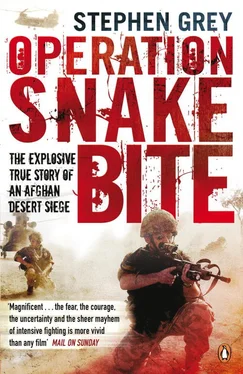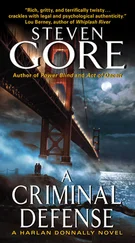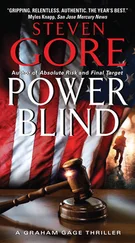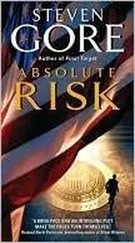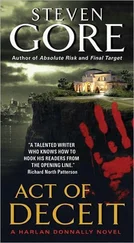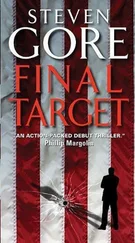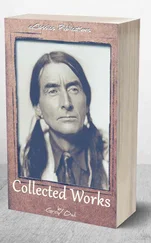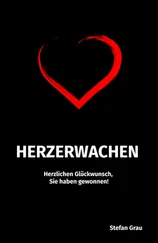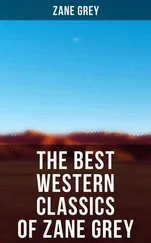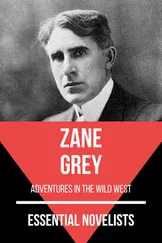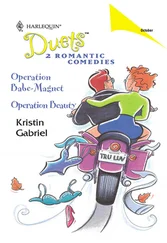Much of the fighting involved exchanges of fire at long distance. But some of it was at close quarters. One of the BRF, acting sergeant John ‘Matty’ Cockburn, would later be awarded a Military Cross, an award for gallantry, for leading a six-man team that charged 200 yards to assault a Taliban trench and captured a prisoner after coming under fire from heavy machine guns.
On the eastern side of Musa Qala, Chris Bell’s Warrior company of the Scots Guards, now code-named on the Taliban radio as the ‘Desert Devils’, kept up a similar routine of camping in hidden positions – often in old Russian trenches – and then moving to the edge of Musa Qala to engage in daily battle.
‘It’s a wearing thing to do for week after week after week,’ said Bell. ‘We were disrupting the enemy but we didn’t know what effect we were having. We certainly knew that we could drive out to any village in the area and cause absolute chaos – women and children running out, mopeds appearing on hills, the guys in black, who were clearly Taliban, directing. We really didn’t know to what degree we were disrupting the enemy. We just knew that we were attracting fire almost every day.’
The squadron of King’s Royal Hussars in their six-wheeled Mastiff armoured vehicles were also in action. Deployed primarily to protect the logistics convoy that kept the Warriors going, they played a game of cat and mouse, moving and hiding the soft-skinned logistics trucks away from Taliban spotters. They also began to launch their own independent attacks against the Taliban defences. The Mastiff was the one vehicle the British had that was practically mine-proof. The squadron was to hit fourteen IEDs and mines – and no one suffered a serious injury in one.
For all their attempts to harass the British troops with mines or mortars, the Taliban were powerless to prevent the build-up of a large armoured encirclement, a sort of ring of fire around Musa Qala. By constantly probing the Taliban’s defences, they steadily turned up the psychological heat on the Taliban forces in the town. It was what Brigadier Mackay called an ‘influence operation’.
Not all activity was productive. Both the KRH and Scots Guards spent days on standby supposedly in readiness to help arrange a secret meeting, instigated by some other agency, between Mullah Salaam and a VIP. They were never told who that was supposed to be, whether it was President Karzai himself or just their brigade commander. ‘All we knew of it,’ said Bell, was that ‘there were people who wanted to speak to Mullah Salami, for whom we were doing all this running around. Every morning it would be “It’s on,” and then “It’s definitely off.” That was our life for about a week, and it never happened. And we were doing a lot of reassurance for him, hanging around his village constantly.’
In the weeks that followed, Bell’s Warriors were withdrawn to prepare for the attack on Musa Qala itself. They were replaced out in the desert around Mullah Salaam’s compound by a squadron of light tanks, the C Squadron of the Household Cavalry Regiment. The handover took place about as far north as British conventional forces had ever reached in Helmand. Circling round through the desert to a point 16 miles north of Musa Qala, the two armoured forces crossed tracks in the stunning scenery of what became called the Grand Canyon Crossing.
Phillips’ BRF had scouted the route and remained in position along it. As the vehicles moved across, the Taliban fired over volley after volley of mortars. The soldiers in armoured vehicles could just jump inside and shut their hatches. The BRF, mostly in their open-topped Land Rovers, could only crouch on the ground.
Brigade headquarters, Lashkar Gah
At brigade headquarters, Major Nick Haston, the deputy chief of staff, was staring at a line of figures on a spreadsheet – and it did not add up. The shortage and state of repair of military equipment in Helmand was already bad, but, with a huge operation now on the cards, it was not clear how the troops would get what they needed.
Haston already had some strong feelings on the subject. In public, politicians and generals were claiming the troops were happy with the equipment they had. But he pointed to a yawning gap between the official military estimates of what was needed for this war and the actual equipment in a working state in Helmand.
A few days before, Brigadier Mackay had signed a forthright ‘ground truth’ memo back to London that warned of a ‘grave’ situation. The facts at the time were stark. According to brigade staff:
Only one-fifth of the total of heavy machine guns required in Helmand were available.
Only half of the required number of WMIK Land Rovers had been supplied, and many that were working in Helmand lacked crucial fittings.
British soldiers were said to have only half the chance of American soldiers of being equipped with night-vision goggles.
Too many engines were not working among the Household Cavalry Regiment’s aged family of Scimitar light reconnaissance tanks. In a perennial problem, many tanks that were declared as ‘working’ could not even go into reverse gear without restarting the engine, a limitation that was ‘not helpful’ in combat.
A quarter of the brand new Mastiff armoured vehicles were out of action for weeks because of a missing supply of cheap suspension springs.
Many of the 6 x 6 Vector armoured vehicles in Helmand were out of action because ‘the wheels just kept falling off, literally’.
This was not to mention simple design flaws in some British vehicles that, according to some military engineers, made their drivers and front-seat commanders (typically officers or NCOs) uniquely vulnerable to being killed by mine strikes. The continued use of such designs was ‘barking mad’, thought Haston. In his memo, Mackay was said to have warned of a ‘grave crisis’ with too much equipment that was ‘tired, limited, and failing regularly’.
Time and again, Haston recalled, he and his team found ways to ‘manage’, but that meant pieces of equipment – from night-vision goggles to machine guns to Land Rovers – were constantly shuffled from one unit to another. Brigade staff, who should have been thinking of the bigger picture, spent time following the fate of an individual set of goggles or even a packet of nuts and bolts.
Held back by a bureaucracy in the UK that was not on a war footing, Haston said he had to bend the rules – buying spares with a credit card on the Internet, for example. And after being kept waiting for weeks for the springs for the Mastiff squadron’s vehicles, it took their commander, Major Richard Slack, to pick up a satellite phone from the desert and phone a factory in Coventry to discover and prove that the springs could be easily made in Britain.
As the Musa Qala operation built up, Haston was having to ‘beg, borrow and steal’ Land Rovers for Helmand from British units based in Kandahar. He would tell them the vehicles he took would be back in a week. ‘I kept lying to them for three months! It’s awful but we did… But that sort of thing creates tension, mistrust…’
The complaints to higher command went down badly, Haston recalled, particularly Mackay’s tersely worded memo. There seemed to be a feeling that 52 Brigade, with its humble origins, was somehow naive – as if real warriors in a real war just managed with what they had. All experienced soldiers, the thinking went, had to tailor their suit to fit their cloth. ‘I think they thought he [Mackay] was slightly naive to write it,’ recalled Haston, ‘when he knew damn fine what he was doing. He did not want this issue smothered.’
When he returned from Afghanistan, Haston was to quit the army in disgust. ‘I’ve resigned for a reason – and some of that reason is that I think there are some mediocre, high-level managers who are unwilling to admit and face up to some of the issues we’ve got… I would say that some of the people that procure [equipment] in our Ministry of Defence haven’t a clue.’
Читать дальше
